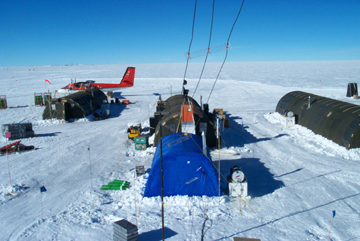
 Lake Vostok lies isolated beneath 4,000
meters of Antarctic ice. Since confirmation of its existence in 1996 and the discovery
of microbes in the ice above, scientists have been looking to the lake to learn
about life in a pristine and extreme environment. Now, the first-ever comprehensive
map of the bottom of Lake Vostok has revealed two distinct basins, which may constitute
separate ecosystems and could alter current efforts to sample the lake.
Lake Vostok lies isolated beneath 4,000
meters of Antarctic ice. Since confirmation of its existence in 1996 and the discovery
of microbes in the ice above, scientists have been looking to the lake to learn
about life in a pristine and extreme environment. Now, the first-ever comprehensive
map of the bottom of Lake Vostok has revealed two distinct basins, which may constitute
separate ecosystems and could alter current efforts to sample the lake. |
Geotimes Home | AGI Home | Information Services | Geoscience Education | Public Policy | Programs | Publications | Careers |